Research Proposal: Illicit Drug Use and Young People in Australia
VerifiedAdded on 2022/12/30
|12
|2721
|1
Report
AI Summary
This report presents a research proposal exploring the issue of illicit drug use among young people in Australia. The study aims to understand the reasons behind the extensive use of illicit drugs within this population. Employing an ethnographic study design, the research will involve qualitative data collection through structured interviews, focusing on individuals aged 15 to 25 who have used drugs. The snowball sampling technique will be used to recruit a sample size of 100 participants. Data analysis will be conducted thematically. The proposal also addresses ethical considerations, including informed consent, confidentiality, and strategies to ensure the rigor of the research. The reflection section considers adaptations needed for young participants, including changes in sampling, data collection, and ethical considerations. The conclusion summarizes the proposed structure's potential to address the issue of illicit drug use in young adults in Australia.
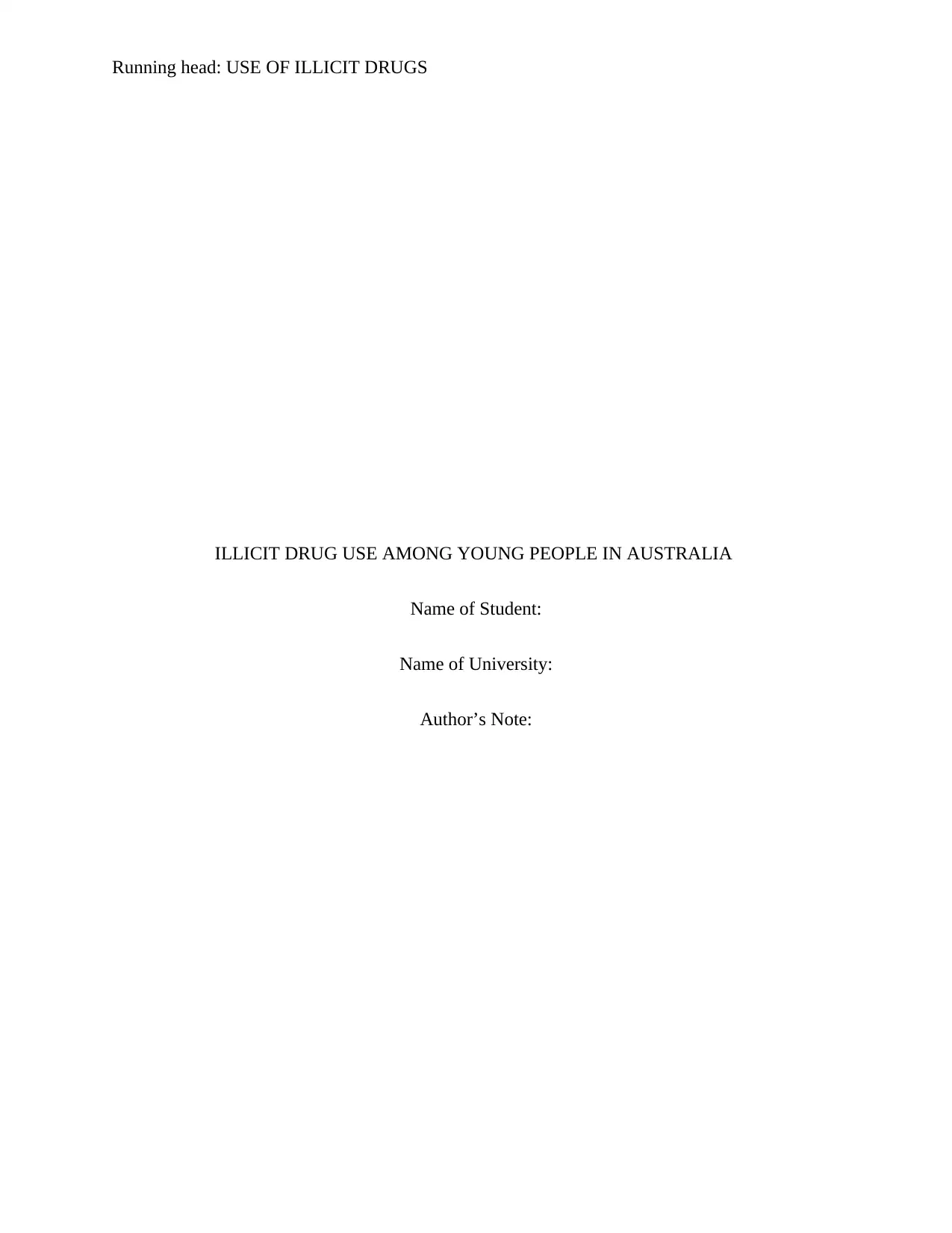
Running head: USE OF ILLICIT DRUGS
ILLICIT DRUG USE AMONG YOUNG PEOPLE IN AUSTRALIA
Name of Student:
Name of University:
Author’s Note:
ILLICIT DRUG USE AMONG YOUNG PEOPLE IN AUSTRALIA
Name of Student:
Name of University:
Author’s Note:
Paraphrase This Document
Need a fresh take? Get an instant paraphrase of this document with our AI Paraphraser
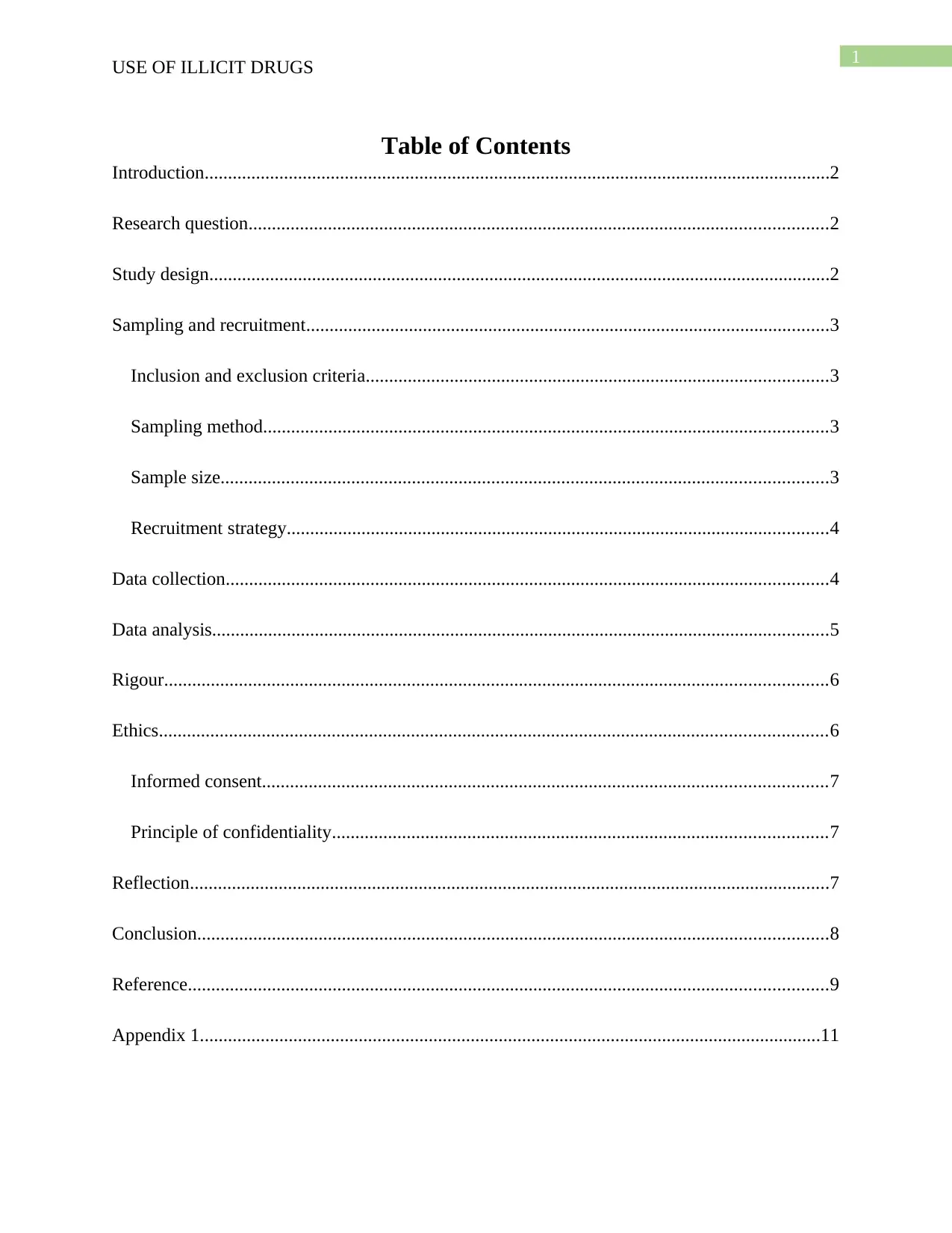
1
USE OF ILLICIT DRUGS
Table of Contents
Introduction......................................................................................................................................2
Research question............................................................................................................................2
Study design.....................................................................................................................................2
Sampling and recruitment................................................................................................................3
Inclusion and exclusion criteria...................................................................................................3
Sampling method.........................................................................................................................3
Sample size..................................................................................................................................3
Recruitment strategy....................................................................................................................4
Data collection.................................................................................................................................4
Data analysis....................................................................................................................................5
Rigour..............................................................................................................................................6
Ethics...............................................................................................................................................6
Informed consent.........................................................................................................................7
Principle of confidentiality..........................................................................................................7
Reflection.........................................................................................................................................7
Conclusion.......................................................................................................................................8
Reference.........................................................................................................................................9
Appendix 1.....................................................................................................................................11
USE OF ILLICIT DRUGS
Table of Contents
Introduction......................................................................................................................................2
Research question............................................................................................................................2
Study design.....................................................................................................................................2
Sampling and recruitment................................................................................................................3
Inclusion and exclusion criteria...................................................................................................3
Sampling method.........................................................................................................................3
Sample size..................................................................................................................................3
Recruitment strategy....................................................................................................................4
Data collection.................................................................................................................................4
Data analysis....................................................................................................................................5
Rigour..............................................................................................................................................6
Ethics...............................................................................................................................................6
Informed consent.........................................................................................................................7
Principle of confidentiality..........................................................................................................7
Reflection.........................................................................................................................................7
Conclusion.......................................................................................................................................8
Reference.........................................................................................................................................9
Appendix 1.....................................................................................................................................11
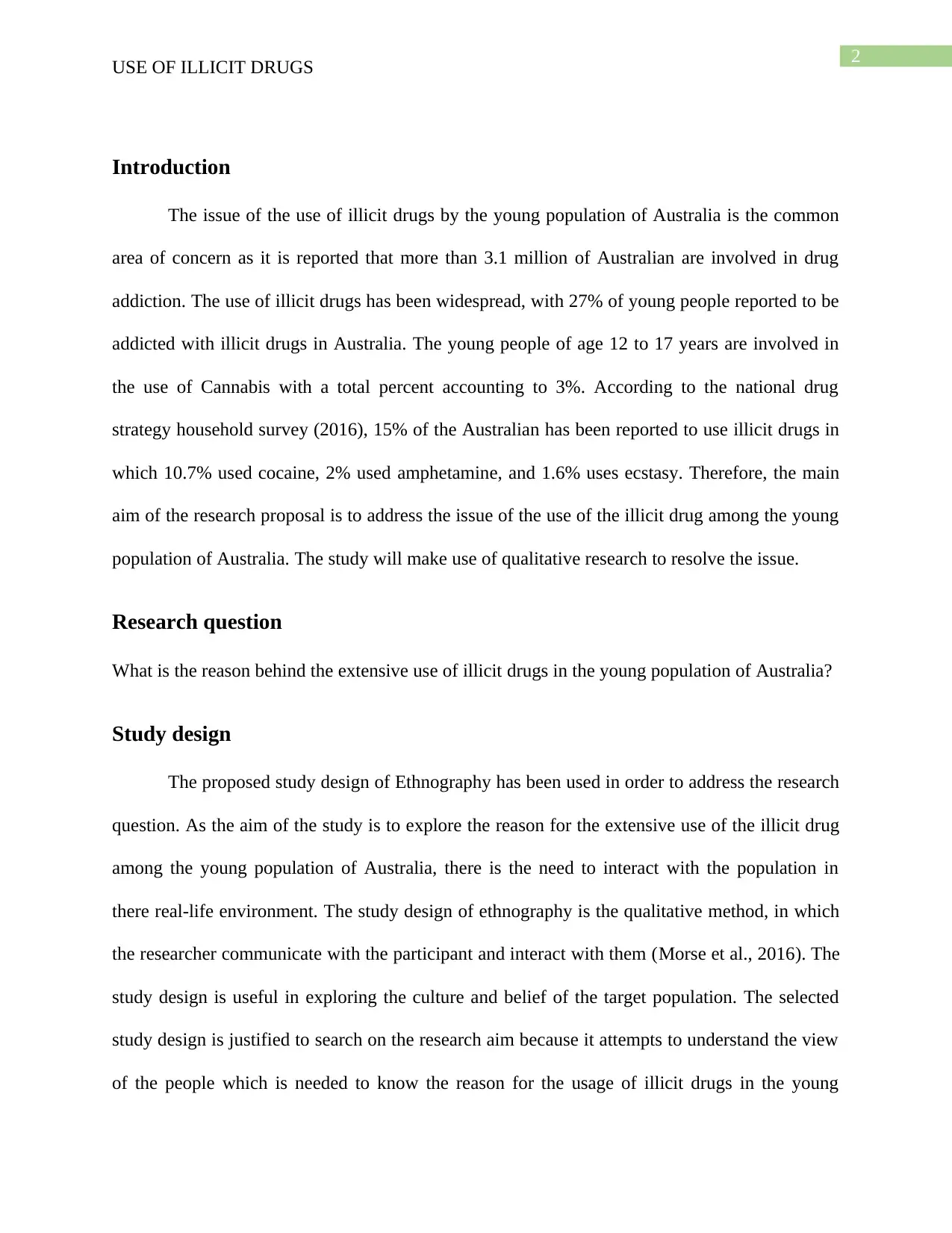
2
USE OF ILLICIT DRUGS
Introduction
The issue of the use of illicit drugs by the young population of Australia is the common
area of concern as it is reported that more than 3.1 million of Australian are involved in drug
addiction. The use of illicit drugs has been widespread, with 27% of young people reported to be
addicted with illicit drugs in Australia. The young people of age 12 to 17 years are involved in
the use of Cannabis with a total percent accounting to 3%. According to the national drug
strategy household survey (2016), 15% of the Australian has been reported to use illicit drugs in
which 10.7% used cocaine, 2% used amphetamine, and 1.6% uses ecstasy. Therefore, the main
aim of the research proposal is to address the issue of the use of the illicit drug among the young
population of Australia. The study will make use of qualitative research to resolve the issue.
Research question
What is the reason behind the extensive use of illicit drugs in the young population of Australia?
Study design
The proposed study design of Ethnography has been used in order to address the research
question. As the aim of the study is to explore the reason for the extensive use of the illicit drug
among the young population of Australia, there is the need to interact with the population in
there real-life environment. The study design of ethnography is the qualitative method, in which
the researcher communicate with the participant and interact with them (Morse et al., 2016). The
study design is useful in exploring the culture and belief of the target population. The selected
study design is justified to search on the research aim because it attempts to understand the view
of the people which is needed to know the reason for the usage of illicit drugs in the young
USE OF ILLICIT DRUGS
Introduction
The issue of the use of illicit drugs by the young population of Australia is the common
area of concern as it is reported that more than 3.1 million of Australian are involved in drug
addiction. The use of illicit drugs has been widespread, with 27% of young people reported to be
addicted with illicit drugs in Australia. The young people of age 12 to 17 years are involved in
the use of Cannabis with a total percent accounting to 3%. According to the national drug
strategy household survey (2016), 15% of the Australian has been reported to use illicit drugs in
which 10.7% used cocaine, 2% used amphetamine, and 1.6% uses ecstasy. Therefore, the main
aim of the research proposal is to address the issue of the use of the illicit drug among the young
population of Australia. The study will make use of qualitative research to resolve the issue.
Research question
What is the reason behind the extensive use of illicit drugs in the young population of Australia?
Study design
The proposed study design of Ethnography has been used in order to address the research
question. As the aim of the study is to explore the reason for the extensive use of the illicit drug
among the young population of Australia, there is the need to interact with the population in
there real-life environment. The study design of ethnography is the qualitative method, in which
the researcher communicate with the participant and interact with them (Morse et al., 2016). The
study design is useful in exploring the culture and belief of the target population. The selected
study design is justified to search on the research aim because it attempts to understand the view
of the people which is needed to know the reason for the usage of illicit drugs in the young
⊘ This is a preview!⊘
Do you want full access?
Subscribe today to unlock all pages.

Trusted by 1+ million students worldwide
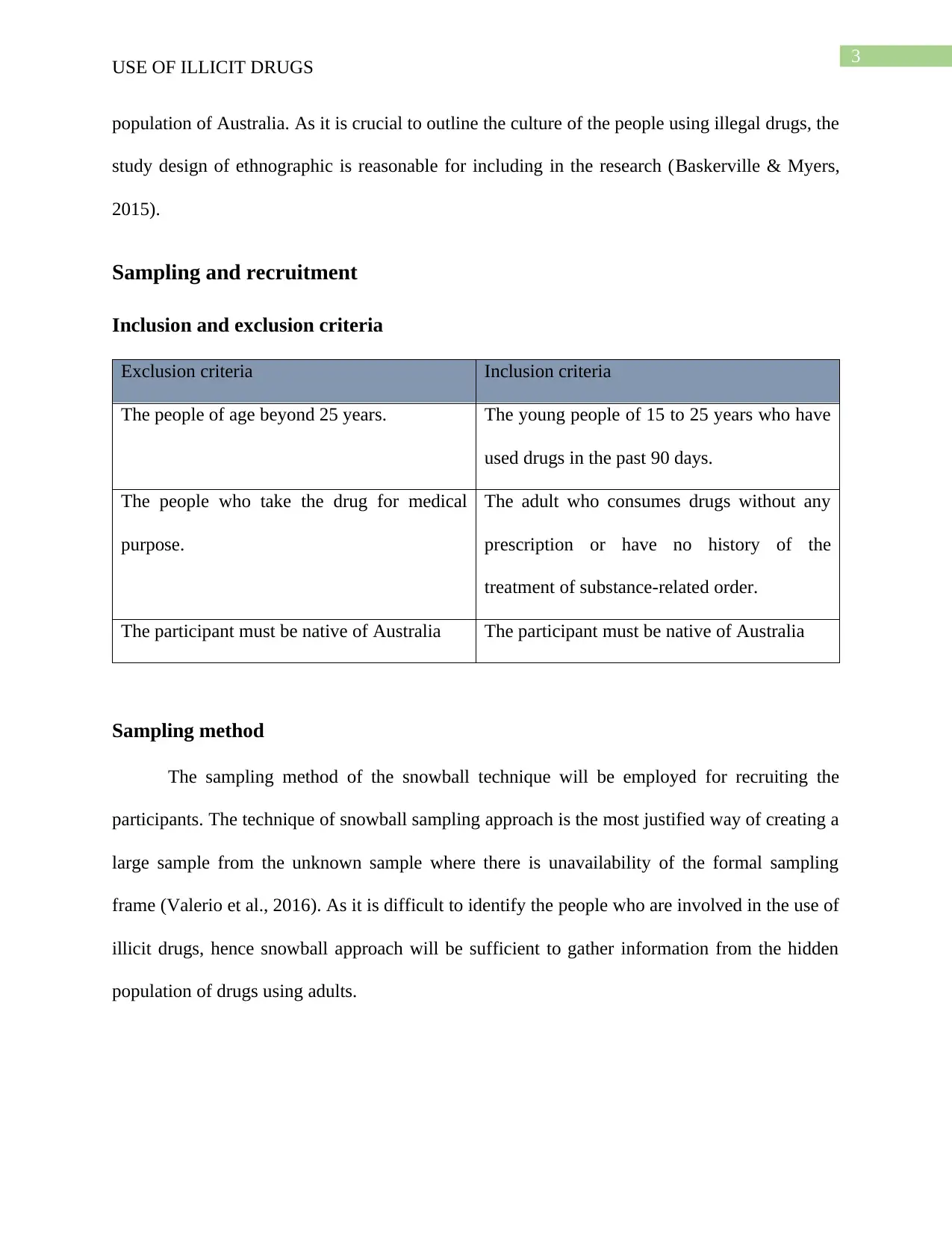
3
USE OF ILLICIT DRUGS
population of Australia. As it is crucial to outline the culture of the people using illegal drugs, the
study design of ethnographic is reasonable for including in the research (Baskerville & Myers,
2015).
Sampling and recruitment
Inclusion and exclusion criteria
Exclusion criteria Inclusion criteria
The people of age beyond 25 years. The young people of 15 to 25 years who have
used drugs in the past 90 days.
The people who take the drug for medical
purpose.
The adult who consumes drugs without any
prescription or have no history of the
treatment of substance-related order.
The participant must be native of Australia The participant must be native of Australia
Sampling method
The sampling method of the snowball technique will be employed for recruiting the
participants. The technique of snowball sampling approach is the most justified way of creating a
large sample from the unknown sample where there is unavailability of the formal sampling
frame (Valerio et al., 2016). As it is difficult to identify the people who are involved in the use of
illicit drugs, hence snowball approach will be sufficient to gather information from the hidden
population of drugs using adults.
USE OF ILLICIT DRUGS
population of Australia. As it is crucial to outline the culture of the people using illegal drugs, the
study design of ethnographic is reasonable for including in the research (Baskerville & Myers,
2015).
Sampling and recruitment
Inclusion and exclusion criteria
Exclusion criteria Inclusion criteria
The people of age beyond 25 years. The young people of 15 to 25 years who have
used drugs in the past 90 days.
The people who take the drug for medical
purpose.
The adult who consumes drugs without any
prescription or have no history of the
treatment of substance-related order.
The participant must be native of Australia The participant must be native of Australia
Sampling method
The sampling method of the snowball technique will be employed for recruiting the
participants. The technique of snowball sampling approach is the most justified way of creating a
large sample from the unknown sample where there is unavailability of the formal sampling
frame (Valerio et al., 2016). As it is difficult to identify the people who are involved in the use of
illicit drugs, hence snowball approach will be sufficient to gather information from the hidden
population of drugs using adults.
Paraphrase This Document
Need a fresh take? Get an instant paraphrase of this document with our AI Paraphraser
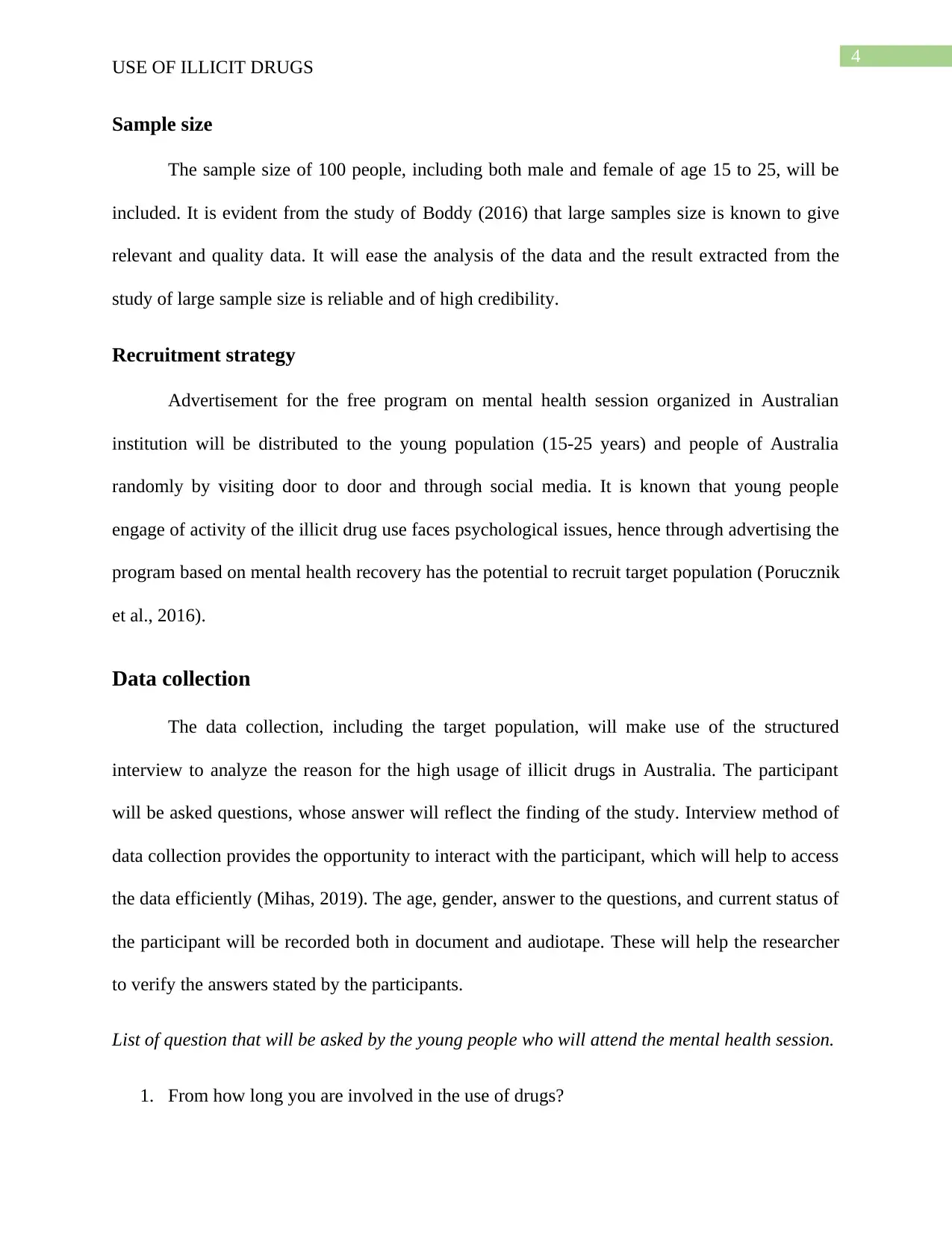
4
USE OF ILLICIT DRUGS
Sample size
The sample size of 100 people, including both male and female of age 15 to 25, will be
included. It is evident from the study of Boddy (2016) that large samples size is known to give
relevant and quality data. It will ease the analysis of the data and the result extracted from the
study of large sample size is reliable and of high credibility.
Recruitment strategy
Advertisement for the free program on mental health session organized in Australian
institution will be distributed to the young population (15-25 years) and people of Australia
randomly by visiting door to door and through social media. It is known that young people
engage of activity of the illicit drug use faces psychological issues, hence through advertising the
program based on mental health recovery has the potential to recruit target population (Porucznik
et al., 2016).
Data collection
The data collection, including the target population, will make use of the structured
interview to analyze the reason for the high usage of illicit drugs in Australia. The participant
will be asked questions, whose answer will reflect the finding of the study. Interview method of
data collection provides the opportunity to interact with the participant, which will help to access
the data efficiently (Mihas, 2019). The age, gender, answer to the questions, and current status of
the participant will be recorded both in document and audiotape. These will help the researcher
to verify the answers stated by the participants.
List of question that will be asked by the young people who will attend the mental health session.
1. From how long you are involved in the use of drugs?
USE OF ILLICIT DRUGS
Sample size
The sample size of 100 people, including both male and female of age 15 to 25, will be
included. It is evident from the study of Boddy (2016) that large samples size is known to give
relevant and quality data. It will ease the analysis of the data and the result extracted from the
study of large sample size is reliable and of high credibility.
Recruitment strategy
Advertisement for the free program on mental health session organized in Australian
institution will be distributed to the young population (15-25 years) and people of Australia
randomly by visiting door to door and through social media. It is known that young people
engage of activity of the illicit drug use faces psychological issues, hence through advertising the
program based on mental health recovery has the potential to recruit target population (Porucznik
et al., 2016).
Data collection
The data collection, including the target population, will make use of the structured
interview to analyze the reason for the high usage of illicit drugs in Australia. The participant
will be asked questions, whose answer will reflect the finding of the study. Interview method of
data collection provides the opportunity to interact with the participant, which will help to access
the data efficiently (Mihas, 2019). The age, gender, answer to the questions, and current status of
the participant will be recorded both in document and audiotape. These will help the researcher
to verify the answers stated by the participants.
List of question that will be asked by the young people who will attend the mental health session.
1. From how long you are involved in the use of drugs?
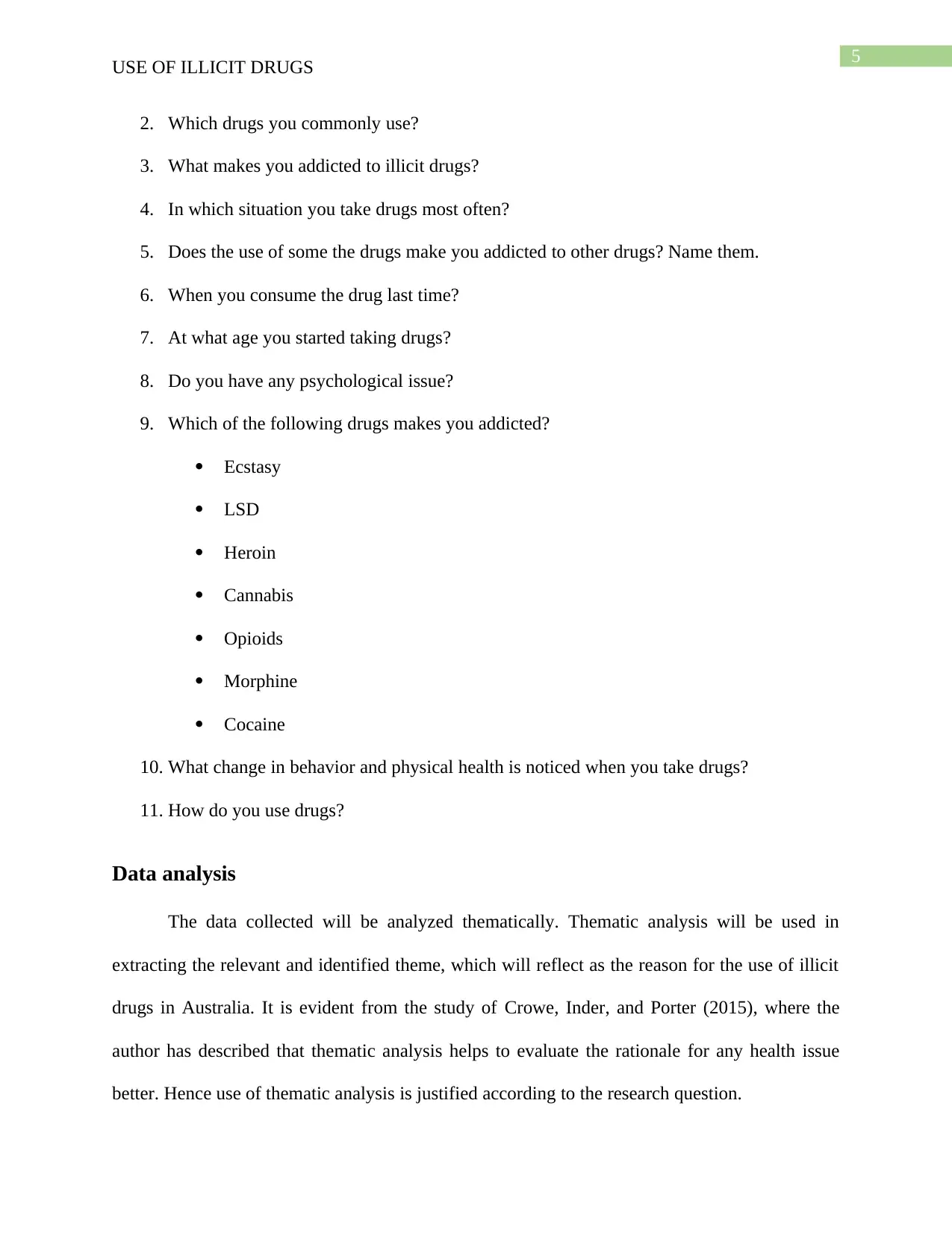
5
USE OF ILLICIT DRUGS
2. Which drugs you commonly use?
3. What makes you addicted to illicit drugs?
4. In which situation you take drugs most often?
5. Does the use of some the drugs make you addicted to other drugs? Name them.
6. When you consume the drug last time?
7. At what age you started taking drugs?
8. Do you have any psychological issue?
9. Which of the following drugs makes you addicted?
Ecstasy
LSD
Heroin
Cannabis
Opioids
Morphine
Cocaine
10. What change in behavior and physical health is noticed when you take drugs?
11. How do you use drugs?
Data analysis
The data collected will be analyzed thematically. Thematic analysis will be used in
extracting the relevant and identified theme, which will reflect as the reason for the use of illicit
drugs in Australia. It is evident from the study of Crowe, Inder, and Porter (2015), where the
author has described that thematic analysis helps to evaluate the rationale for any health issue
better. Hence use of thematic analysis is justified according to the research question.
USE OF ILLICIT DRUGS
2. Which drugs you commonly use?
3. What makes you addicted to illicit drugs?
4. In which situation you take drugs most often?
5. Does the use of some the drugs make you addicted to other drugs? Name them.
6. When you consume the drug last time?
7. At what age you started taking drugs?
8. Do you have any psychological issue?
9. Which of the following drugs makes you addicted?
Ecstasy
LSD
Heroin
Cannabis
Opioids
Morphine
Cocaine
10. What change in behavior and physical health is noticed when you take drugs?
11. How do you use drugs?
Data analysis
The data collected will be analyzed thematically. Thematic analysis will be used in
extracting the relevant and identified theme, which will reflect as the reason for the use of illicit
drugs in Australia. It is evident from the study of Crowe, Inder, and Porter (2015), where the
author has described that thematic analysis helps to evaluate the rationale for any health issue
better. Hence use of thematic analysis is justified according to the research question.
⊘ This is a preview!⊘
Do you want full access?
Subscribe today to unlock all pages.

Trusted by 1+ million students worldwide
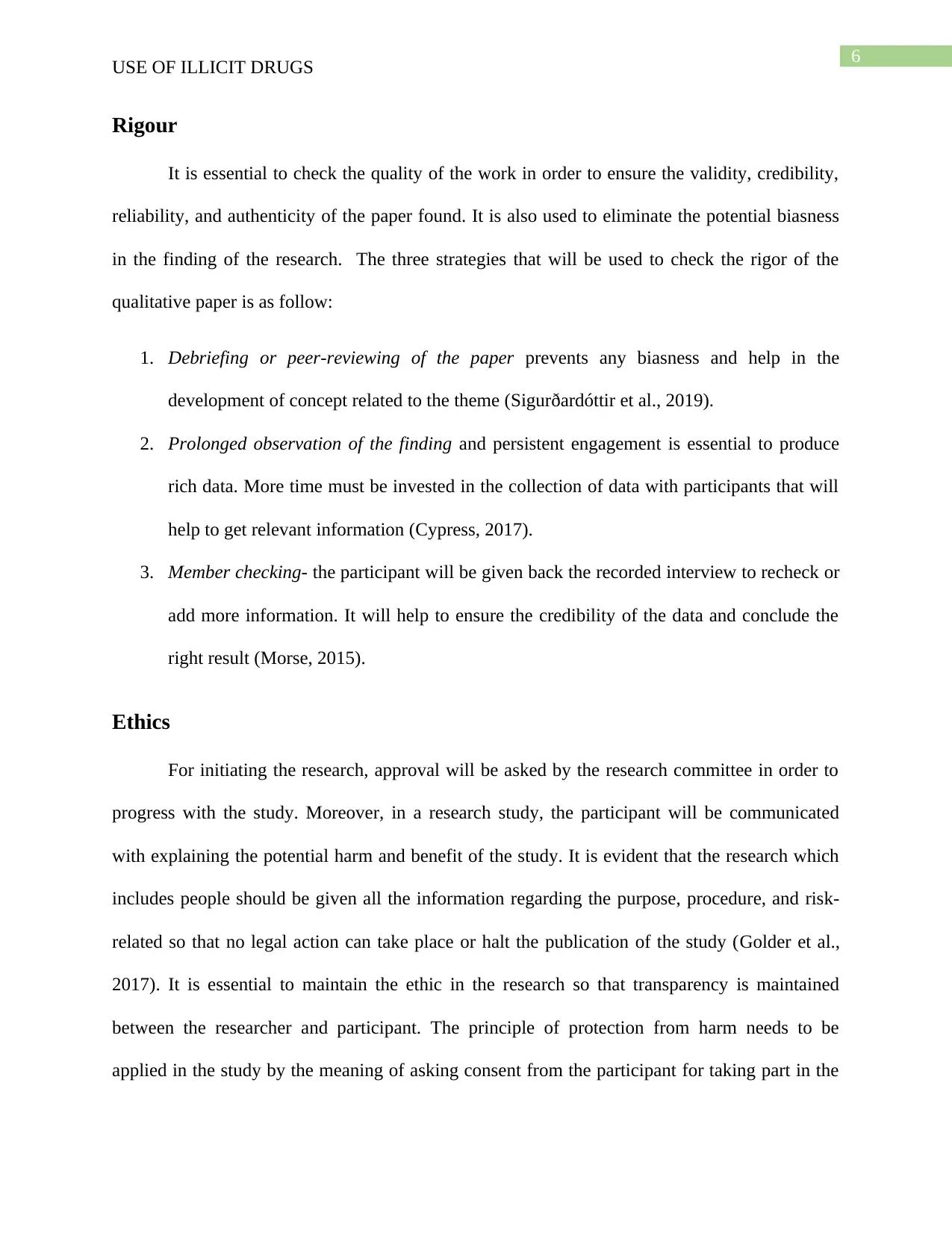
6
USE OF ILLICIT DRUGS
Rigour
It is essential to check the quality of the work in order to ensure the validity, credibility,
reliability, and authenticity of the paper found. It is also used to eliminate the potential biasness
in the finding of the research. The three strategies that will be used to check the rigor of the
qualitative paper is as follow:
1. Debriefing or peer-reviewing of the paper prevents any biasness and help in the
development of concept related to the theme (Sigurðardóttir et al., 2019).
2. Prolonged observation of the finding and persistent engagement is essential to produce
rich data. More time must be invested in the collection of data with participants that will
help to get relevant information (Cypress, 2017).
3. Member checking- the participant will be given back the recorded interview to recheck or
add more information. It will help to ensure the credibility of the data and conclude the
right result (Morse, 2015).
Ethics
For initiating the research, approval will be asked by the research committee in order to
progress with the study. Moreover, in a research study, the participant will be communicated
with explaining the potential harm and benefit of the study. It is evident that the research which
includes people should be given all the information regarding the purpose, procedure, and risk-
related so that no legal action can take place or halt the publication of the study (Golder et al.,
2017). It is essential to maintain the ethic in the research so that transparency is maintained
between the researcher and participant. The principle of protection from harm needs to be
applied in the study by the meaning of asking consent from the participant for taking part in the
USE OF ILLICIT DRUGS
Rigour
It is essential to check the quality of the work in order to ensure the validity, credibility,
reliability, and authenticity of the paper found. It is also used to eliminate the potential biasness
in the finding of the research. The three strategies that will be used to check the rigor of the
qualitative paper is as follow:
1. Debriefing or peer-reviewing of the paper prevents any biasness and help in the
development of concept related to the theme (Sigurðardóttir et al., 2019).
2. Prolonged observation of the finding and persistent engagement is essential to produce
rich data. More time must be invested in the collection of data with participants that will
help to get relevant information (Cypress, 2017).
3. Member checking- the participant will be given back the recorded interview to recheck or
add more information. It will help to ensure the credibility of the data and conclude the
right result (Morse, 2015).
Ethics
For initiating the research, approval will be asked by the research committee in order to
progress with the study. Moreover, in a research study, the participant will be communicated
with explaining the potential harm and benefit of the study. It is evident that the research which
includes people should be given all the information regarding the purpose, procedure, and risk-
related so that no legal action can take place or halt the publication of the study (Golder et al.,
2017). It is essential to maintain the ethic in the research so that transparency is maintained
between the researcher and participant. The principle of protection from harm needs to be
applied in the study by the meaning of asking consent from the participant for taking part in the
Paraphrase This Document
Need a fresh take? Get an instant paraphrase of this document with our AI Paraphraser
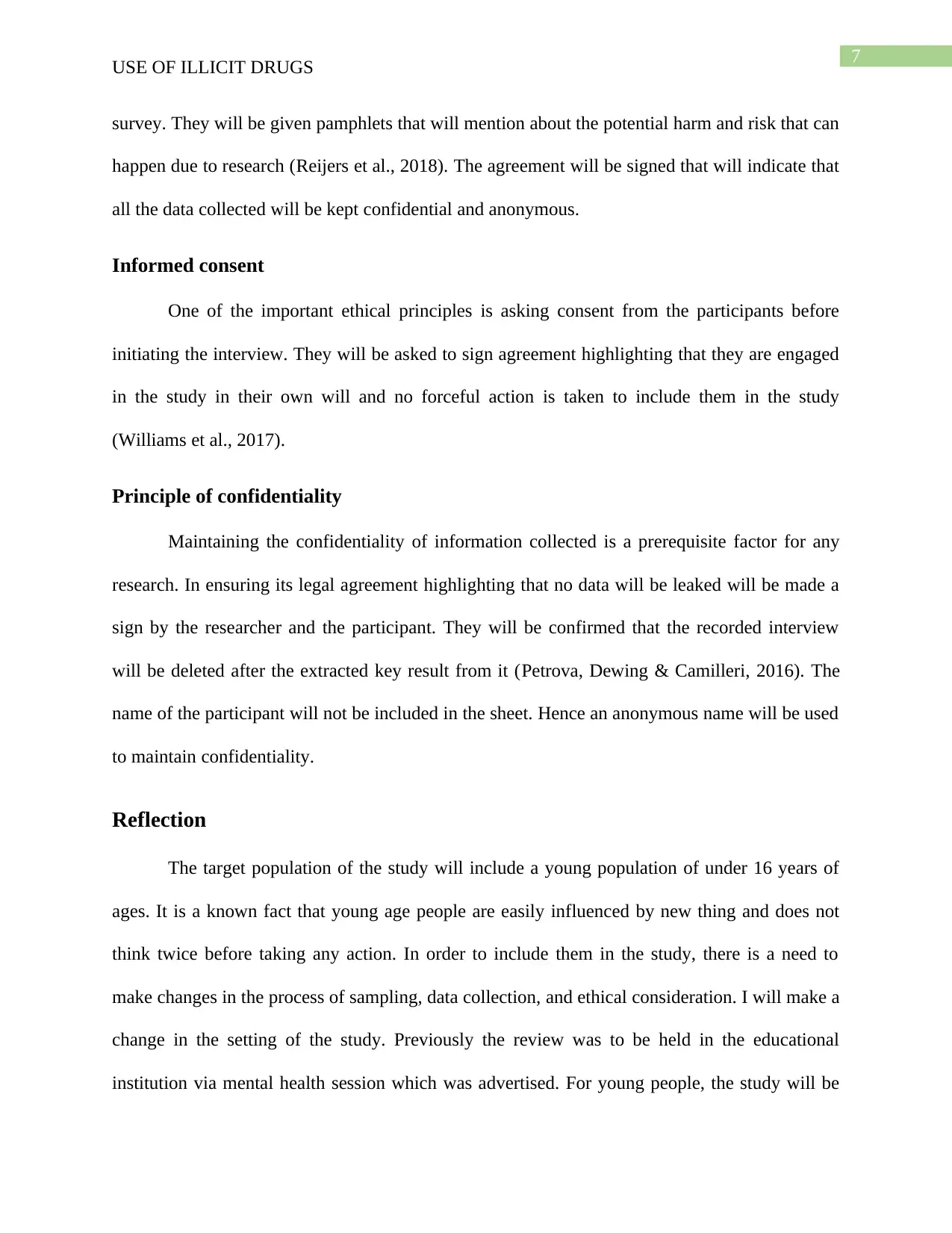
7
USE OF ILLICIT DRUGS
survey. They will be given pamphlets that will mention about the potential harm and risk that can
happen due to research (Reijers et al., 2018). The agreement will be signed that will indicate that
all the data collected will be kept confidential and anonymous.
Informed consent
One of the important ethical principles is asking consent from the participants before
initiating the interview. They will be asked to sign agreement highlighting that they are engaged
in the study in their own will and no forceful action is taken to include them in the study
(Williams et al., 2017).
Principle of confidentiality
Maintaining the confidentiality of information collected is a prerequisite factor for any
research. In ensuring its legal agreement highlighting that no data will be leaked will be made a
sign by the researcher and the participant. They will be confirmed that the recorded interview
will be deleted after the extracted key result from it (Petrova, Dewing & Camilleri, 2016). The
name of the participant will not be included in the sheet. Hence an anonymous name will be used
to maintain confidentiality.
Reflection
The target population of the study will include a young population of under 16 years of
ages. It is a known fact that young age people are easily influenced by new thing and does not
think twice before taking any action. In order to include them in the study, there is a need to
make changes in the process of sampling, data collection, and ethical consideration. I will make a
change in the setting of the study. Previously the review was to be held in the educational
institution via mental health session which was advertised. For young people, the study will be
USE OF ILLICIT DRUGS
survey. They will be given pamphlets that will mention about the potential harm and risk that can
happen due to research (Reijers et al., 2018). The agreement will be signed that will indicate that
all the data collected will be kept confidential and anonymous.
Informed consent
One of the important ethical principles is asking consent from the participants before
initiating the interview. They will be asked to sign agreement highlighting that they are engaged
in the study in their own will and no forceful action is taken to include them in the study
(Williams et al., 2017).
Principle of confidentiality
Maintaining the confidentiality of information collected is a prerequisite factor for any
research. In ensuring its legal agreement highlighting that no data will be leaked will be made a
sign by the researcher and the participant. They will be confirmed that the recorded interview
will be deleted after the extracted key result from it (Petrova, Dewing & Camilleri, 2016). The
name of the participant will not be included in the sheet. Hence an anonymous name will be used
to maintain confidentiality.
Reflection
The target population of the study will include a young population of under 16 years of
ages. It is a known fact that young age people are easily influenced by new thing and does not
think twice before taking any action. In order to include them in the study, there is a need to
make changes in the process of sampling, data collection, and ethical consideration. I will make a
change in the setting of the study. Previously the review was to be held in the educational
institution via mental health session which was advertised. For young people, the study will be
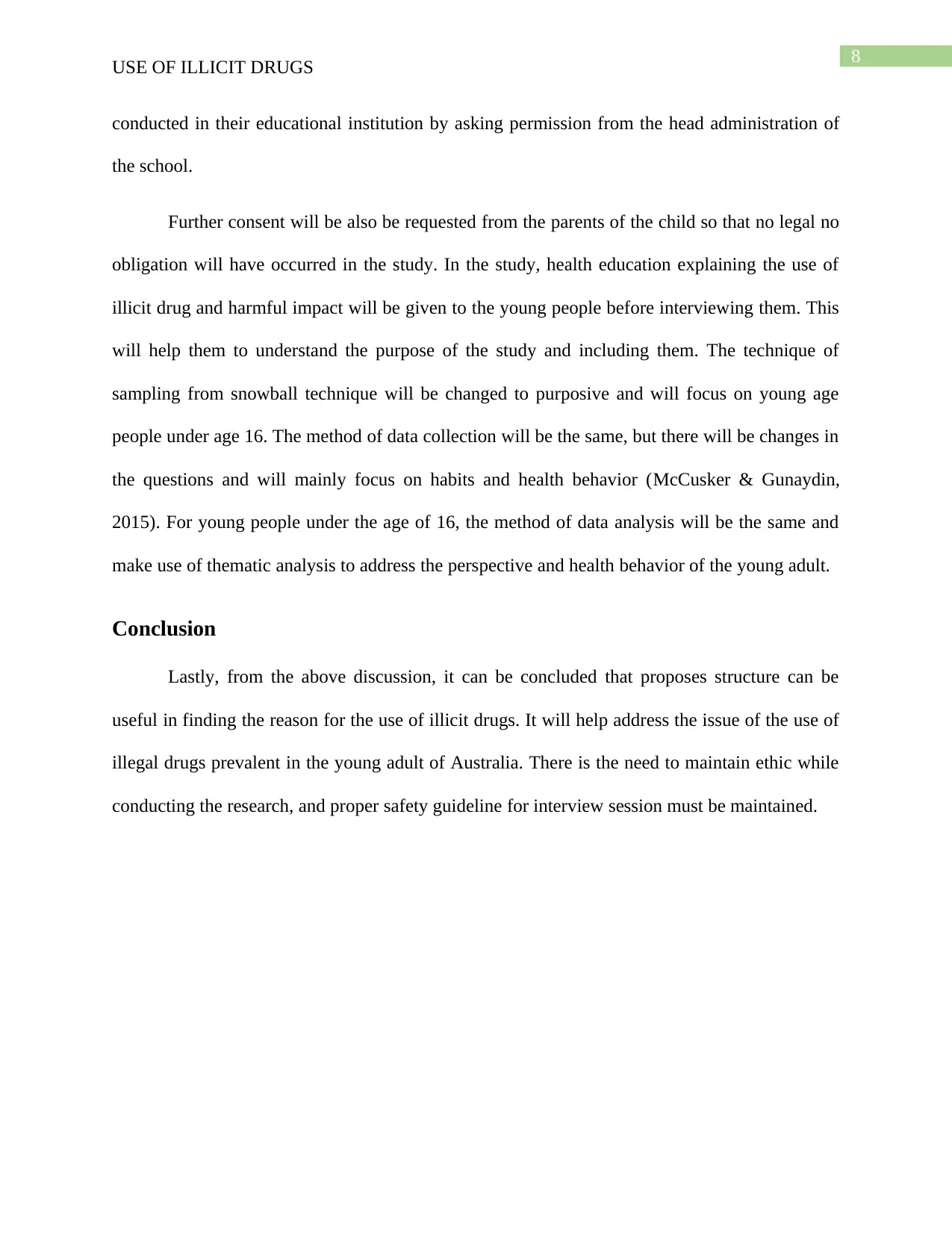
8
USE OF ILLICIT DRUGS
conducted in their educational institution by asking permission from the head administration of
the school.
Further consent will be also be requested from the parents of the child so that no legal no
obligation will have occurred in the study. In the study, health education explaining the use of
illicit drug and harmful impact will be given to the young people before interviewing them. This
will help them to understand the purpose of the study and including them. The technique of
sampling from snowball technique will be changed to purposive and will focus on young age
people under age 16. The method of data collection will be the same, but there will be changes in
the questions and will mainly focus on habits and health behavior (McCusker & Gunaydin,
2015). For young people under the age of 16, the method of data analysis will be the same and
make use of thematic analysis to address the perspective and health behavior of the young adult.
Conclusion
Lastly, from the above discussion, it can be concluded that proposes structure can be
useful in finding the reason for the use of illicit drugs. It will help address the issue of the use of
illegal drugs prevalent in the young adult of Australia. There is the need to maintain ethic while
conducting the research, and proper safety guideline for interview session must be maintained.
USE OF ILLICIT DRUGS
conducted in their educational institution by asking permission from the head administration of
the school.
Further consent will be also be requested from the parents of the child so that no legal no
obligation will have occurred in the study. In the study, health education explaining the use of
illicit drug and harmful impact will be given to the young people before interviewing them. This
will help them to understand the purpose of the study and including them. The technique of
sampling from snowball technique will be changed to purposive and will focus on young age
people under age 16. The method of data collection will be the same, but there will be changes in
the questions and will mainly focus on habits and health behavior (McCusker & Gunaydin,
2015). For young people under the age of 16, the method of data analysis will be the same and
make use of thematic analysis to address the perspective and health behavior of the young adult.
Conclusion
Lastly, from the above discussion, it can be concluded that proposes structure can be
useful in finding the reason for the use of illicit drugs. It will help address the issue of the use of
illegal drugs prevalent in the young adult of Australia. There is the need to maintain ethic while
conducting the research, and proper safety guideline for interview session must be maintained.
⊘ This is a preview!⊘
Do you want full access?
Subscribe today to unlock all pages.

Trusted by 1+ million students worldwide
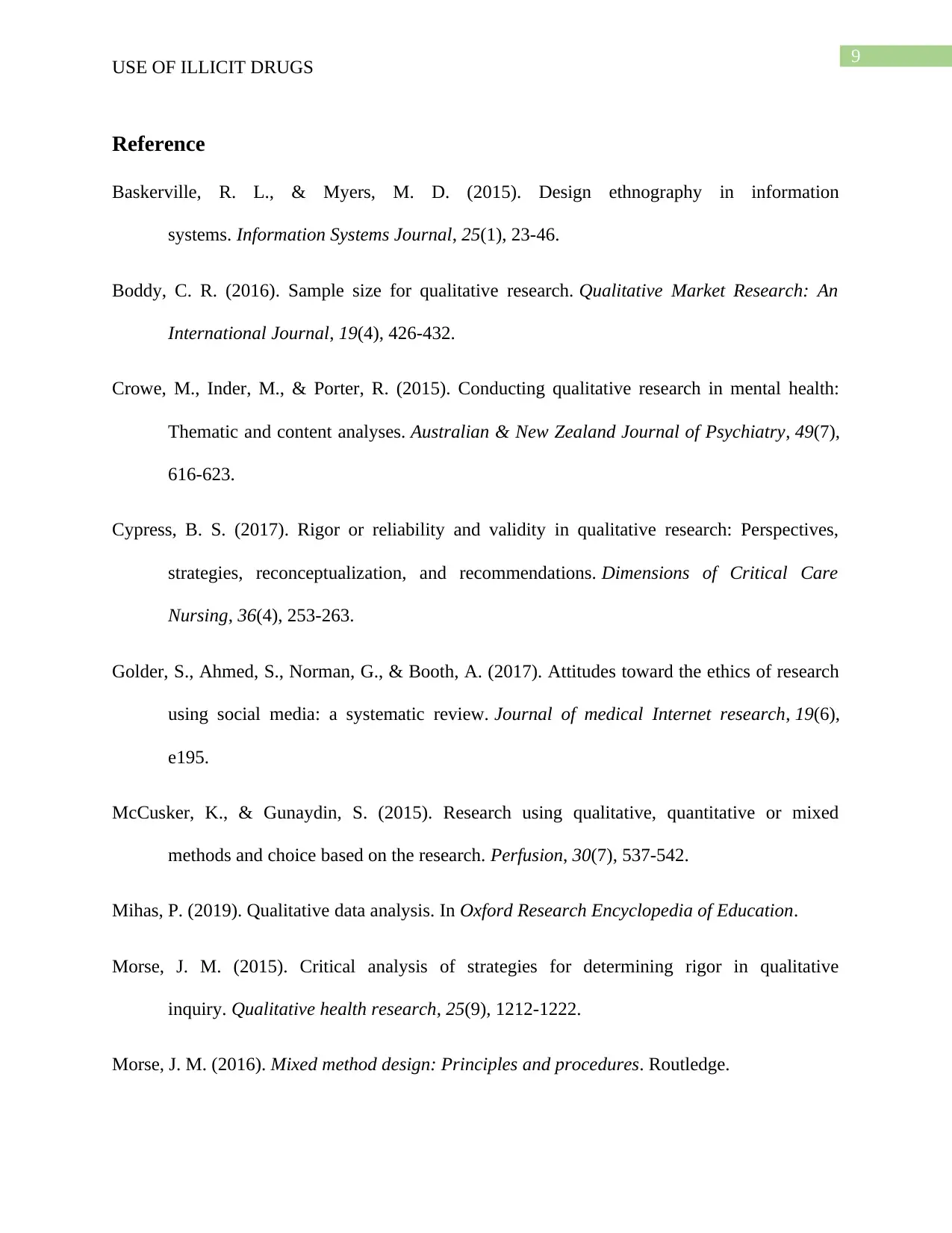
9
USE OF ILLICIT DRUGS
Reference
Baskerville, R. L., & Myers, M. D. (2015). Design ethnography in information
systems. Information Systems Journal, 25(1), 23-46.
Boddy, C. R. (2016). Sample size for qualitative research. Qualitative Market Research: An
International Journal, 19(4), 426-432.
Crowe, M., Inder, M., & Porter, R. (2015). Conducting qualitative research in mental health:
Thematic and content analyses. Australian & New Zealand Journal of Psychiatry, 49(7),
616-623.
Cypress, B. S. (2017). Rigor or reliability and validity in qualitative research: Perspectives,
strategies, reconceptualization, and recommendations. Dimensions of Critical Care
Nursing, 36(4), 253-263.
Golder, S., Ahmed, S., Norman, G., & Booth, A. (2017). Attitudes toward the ethics of research
using social media: a systematic review. Journal of medical Internet research, 19(6),
e195.
McCusker, K., & Gunaydin, S. (2015). Research using qualitative, quantitative or mixed
methods and choice based on the research. Perfusion, 30(7), 537-542.
Mihas, P. (2019). Qualitative data analysis. In Oxford Research Encyclopedia of Education.
Morse, J. M. (2015). Critical analysis of strategies for determining rigor in qualitative
inquiry. Qualitative health research, 25(9), 1212-1222.
Morse, J. M. (2016). Mixed method design: Principles and procedures. Routledge.
USE OF ILLICIT DRUGS
Reference
Baskerville, R. L., & Myers, M. D. (2015). Design ethnography in information
systems. Information Systems Journal, 25(1), 23-46.
Boddy, C. R. (2016). Sample size for qualitative research. Qualitative Market Research: An
International Journal, 19(4), 426-432.
Crowe, M., Inder, M., & Porter, R. (2015). Conducting qualitative research in mental health:
Thematic and content analyses. Australian & New Zealand Journal of Psychiatry, 49(7),
616-623.
Cypress, B. S. (2017). Rigor or reliability and validity in qualitative research: Perspectives,
strategies, reconceptualization, and recommendations. Dimensions of Critical Care
Nursing, 36(4), 253-263.
Golder, S., Ahmed, S., Norman, G., & Booth, A. (2017). Attitudes toward the ethics of research
using social media: a systematic review. Journal of medical Internet research, 19(6),
e195.
McCusker, K., & Gunaydin, S. (2015). Research using qualitative, quantitative or mixed
methods and choice based on the research. Perfusion, 30(7), 537-542.
Mihas, P. (2019). Qualitative data analysis. In Oxford Research Encyclopedia of Education.
Morse, J. M. (2015). Critical analysis of strategies for determining rigor in qualitative
inquiry. Qualitative health research, 25(9), 1212-1222.
Morse, J. M. (2016). Mixed method design: Principles and procedures. Routledge.
Paraphrase This Document
Need a fresh take? Get an instant paraphrase of this document with our AI Paraphraser
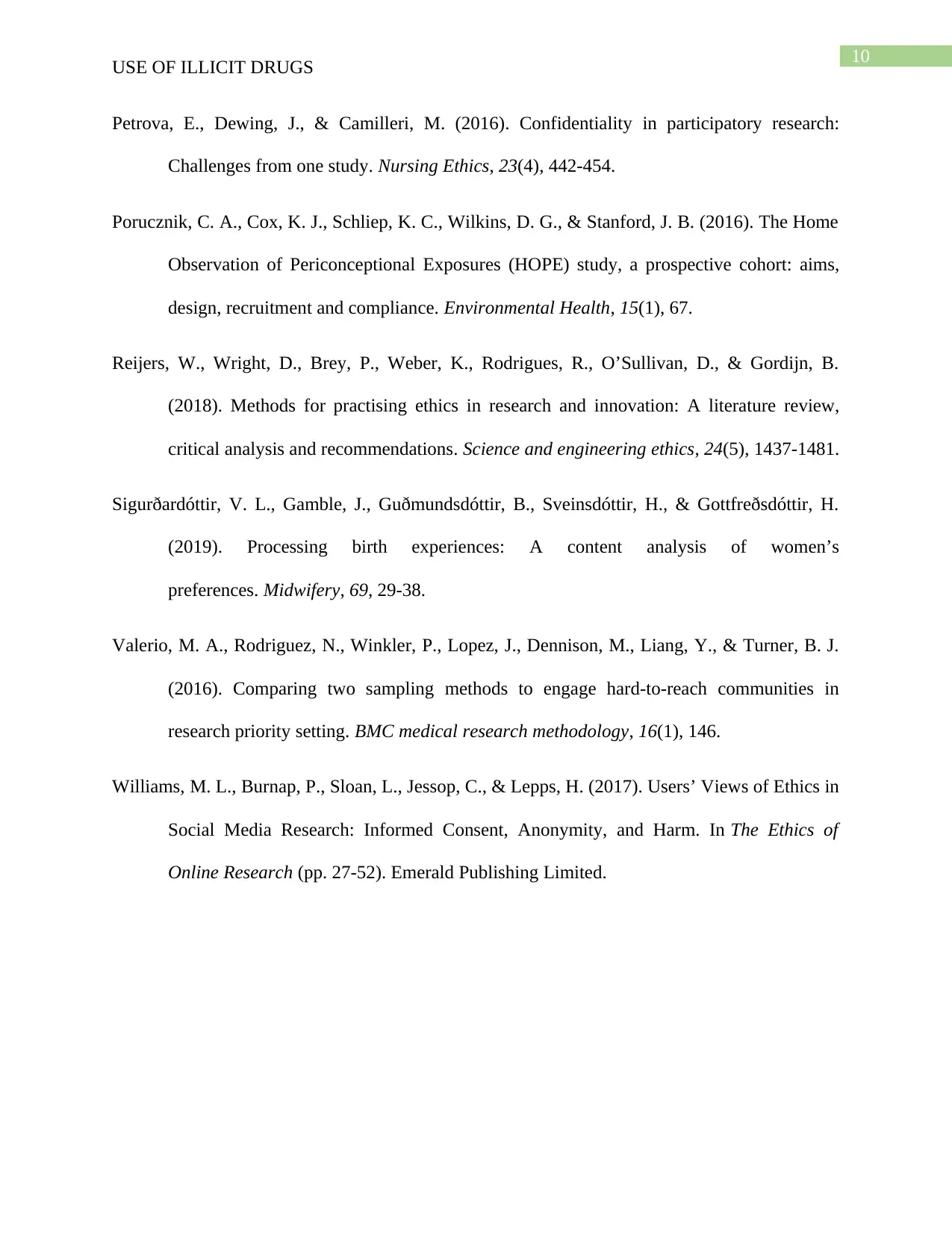
10
USE OF ILLICIT DRUGS
Petrova, E., Dewing, J., & Camilleri, M. (2016). Confidentiality in participatory research:
Challenges from one study. Nursing Ethics, 23(4), 442-454.
Porucznik, C. A., Cox, K. J., Schliep, K. C., Wilkins, D. G., & Stanford, J. B. (2016). The Home
Observation of Periconceptional Exposures (HOPE) study, a prospective cohort: aims,
design, recruitment and compliance. Environmental Health, 15(1), 67.
Reijers, W., Wright, D., Brey, P., Weber, K., Rodrigues, R., O’Sullivan, D., & Gordijn, B.
(2018). Methods for practising ethics in research and innovation: A literature review,
critical analysis and recommendations. Science and engineering ethics, 24(5), 1437-1481.
Sigurðardóttir, V. L., Gamble, J., Guðmundsdóttir, B., Sveinsdóttir, H., & Gottfreðsdóttir, H.
(2019). Processing birth experiences: A content analysis of women’s
preferences. Midwifery, 69, 29-38.
Valerio, M. A., Rodriguez, N., Winkler, P., Lopez, J., Dennison, M., Liang, Y., & Turner, B. J.
(2016). Comparing two sampling methods to engage hard-to-reach communities in
research priority setting. BMC medical research methodology, 16(1), 146.
Williams, M. L., Burnap, P., Sloan, L., Jessop, C., & Lepps, H. (2017). Users’ Views of Ethics in
Social Media Research: Informed Consent, Anonymity, and Harm. In The Ethics of
Online Research (pp. 27-52). Emerald Publishing Limited.
USE OF ILLICIT DRUGS
Petrova, E., Dewing, J., & Camilleri, M. (2016). Confidentiality in participatory research:
Challenges from one study. Nursing Ethics, 23(4), 442-454.
Porucznik, C. A., Cox, K. J., Schliep, K. C., Wilkins, D. G., & Stanford, J. B. (2016). The Home
Observation of Periconceptional Exposures (HOPE) study, a prospective cohort: aims,
design, recruitment and compliance. Environmental Health, 15(1), 67.
Reijers, W., Wright, D., Brey, P., Weber, K., Rodrigues, R., O’Sullivan, D., & Gordijn, B.
(2018). Methods for practising ethics in research and innovation: A literature review,
critical analysis and recommendations. Science and engineering ethics, 24(5), 1437-1481.
Sigurðardóttir, V. L., Gamble, J., Guðmundsdóttir, B., Sveinsdóttir, H., & Gottfreðsdóttir, H.
(2019). Processing birth experiences: A content analysis of women’s
preferences. Midwifery, 69, 29-38.
Valerio, M. A., Rodriguez, N., Winkler, P., Lopez, J., Dennison, M., Liang, Y., & Turner, B. J.
(2016). Comparing two sampling methods to engage hard-to-reach communities in
research priority setting. BMC medical research methodology, 16(1), 146.
Williams, M. L., Burnap, P., Sloan, L., Jessop, C., & Lepps, H. (2017). Users’ Views of Ethics in
Social Media Research: Informed Consent, Anonymity, and Harm. In The Ethics of
Online Research (pp. 27-52). Emerald Publishing Limited.
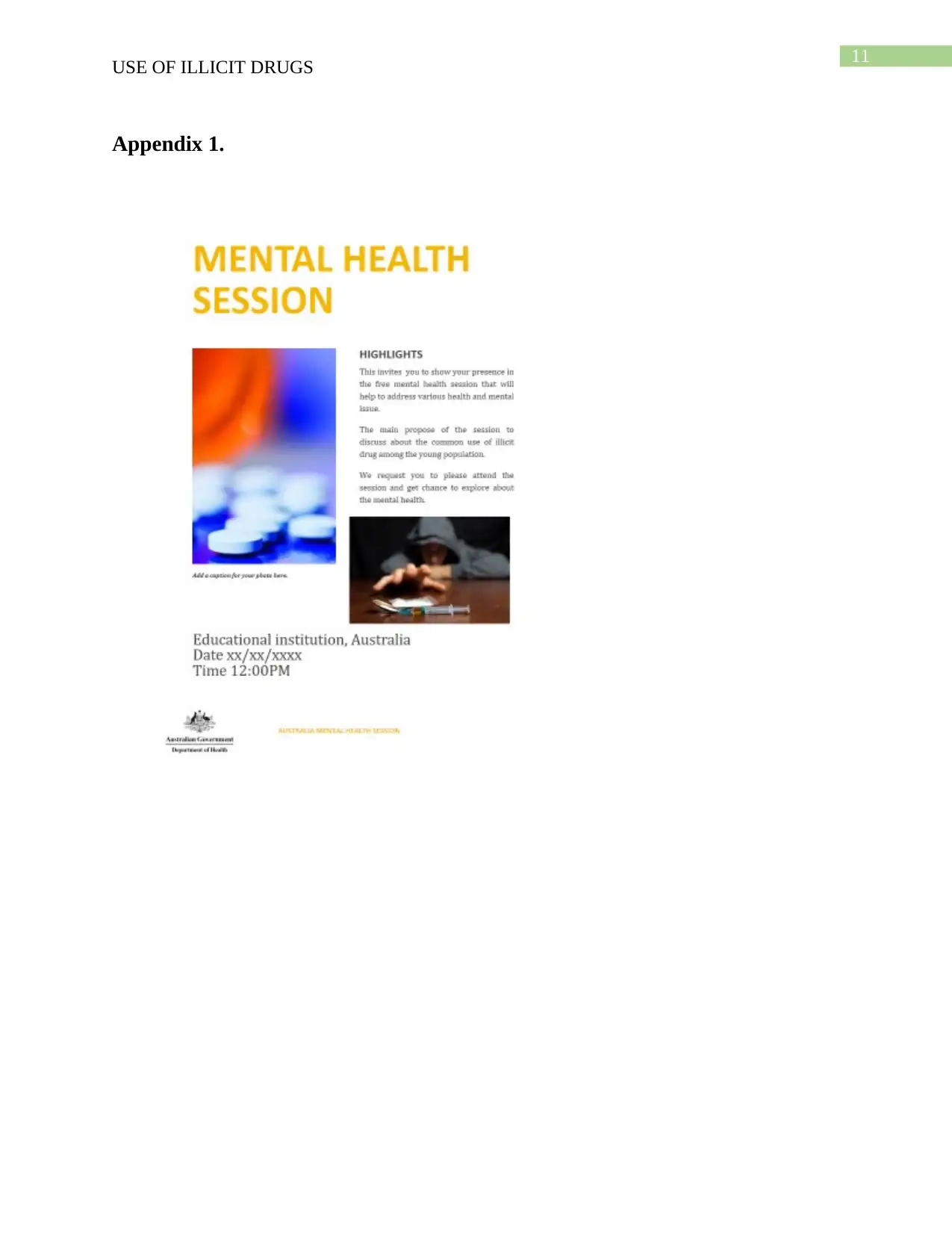
11
USE OF ILLICIT DRUGS
Appendix 1.
USE OF ILLICIT DRUGS
Appendix 1.
⊘ This is a preview!⊘
Do you want full access?
Subscribe today to unlock all pages.

Trusted by 1+ million students worldwide
1 out of 12
Related Documents
Your All-in-One AI-Powered Toolkit for Academic Success.
+13062052269
info@desklib.com
Available 24*7 on WhatsApp / Email
![[object Object]](/_next/static/media/star-bottom.7253800d.svg)
Unlock your academic potential
Copyright © 2020–2025 A2Z Services. All Rights Reserved. Developed and managed by ZUCOL.




